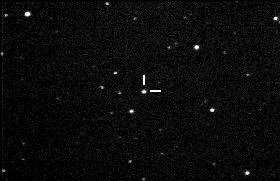

The asteroid Eros in 1995, shining at 13 magnitude.
Observations by Grange Obs. Newton 0.3 m f/4 + CCD + red filter, GSC reference stars (J2000). 00433 C1995 09 14.89861 00 00 55.14 +25 01 24.3 476 00433 C1995 09 14.90521 00 00 54.46 +25 01 27.0 476 00433 C1995 09 14.90868 00 00 54.06 +25 01 28.6 476 00433 C1995 09 14.91319 00 00 53.59 +25 01 31.1 476 00433 C1995 09 14.91875 00 00 53.02 +25 01 33.2 476 00433 C1995 10 01.97396 23 28 25.19 +25 42 10.6 476 00433 C1995 10 01.98333 23 28 24.02 +25 42 09.6 476 00433 C1995 10 01.98924 23 28 23.26 +25 42 09.0 476 00433 C1995 11 14.87882 22 52 07.18 +19 27 01.8 476 00433 C1995 11 14.88368 22 52 07.32 +19 26 59.2 476 00433 C1995 11 14.88785 22 52 07.46 +19 26 57.7 476 00433 C1995 11 14.89931 22 52 07.81 +19 26 52.2 476 00433 C1995 12 17.83438 23 37 49.97 +17 39 28.0 476 00433 C1995 12 17.83924 23 37 50.51 +17 39 28.5 476 00433 C1995 12 17.84583 23 37 51.37 +17 39 29.0 476 00433 C1996 01 18.83177 01 00 29.27 +19 28 47.8 476 00433 C1996 01 18.83646 01 00 30.12 +19 28 49.0 476 00433 C1996 02 14.85938 02 31 29.93 +21 29 49.6 476 00433 C1996 02 14.86927 02 31 32.08 +21 29 51.9 476 00433 C1996 02 14.87379 02 31 33.03 +21 29 52.7 476 00433 C1996 02 14.88212 02 31 34.88 +21 29 54.1 476 00433 C1996 02 14.88941 02 31 36.45 +21 29 55.2 476 00433 C1996 03 11.82726 04 11 41.24 +21 40 06.9 476 00433 C1996 03 11.84306 04 11 45.03 +21 40 03.9 476 00433 C1996 04 15.86979 06 31 28.95 +17 06 15.0 476 00433 C1996 04 15.87517 06 31 30.21 +17 06 10.9 476 00433 C1996 04 15.88663 06 31 32.86 +17 06 02.2 476 Total of 27 observations.During that period the following pictures have been taken, showing the asteroid's motion:


(433) Eros Perihelion 1999 Sep 20.409410 TT Epoch 2000 Feb 26.0 TT = JDT 2451600.5 M 88.75617 (2000.0) P Q n 0.55965596 Peri. 178.64386 -0.54587846 -0.82340557 a 1.4583283 Node 304.41709 0.76694605 -0.41657327 e 0.2227764 Incl. 10.82860 0.33735806 -0.38531801 P 1.76 q 1.1334472 From 27 observations at Grange Obs. 1995 Sep. 14-1996 Apr. 15; RMS error 0.591 arcseconds
(433) Eros Epoch 2000 Feb. 26.0 TT = JDT 2451600.5 (M-N) Williams M 88.75095 (2000.0) P Q n 0.55964439 Peri. 178.64814 -0.54589653 -0.82339289 a 1.4583484 Node 304.41411 +0.76694093 -0.41659247 e 0.2227670 Incl. 10.82848 +0.33734047 -0.38532437 P 1.76 H 11.16 G 0.46 From 2402 observations at 42 oppositions, 1893-1993, mean residual 0".72.